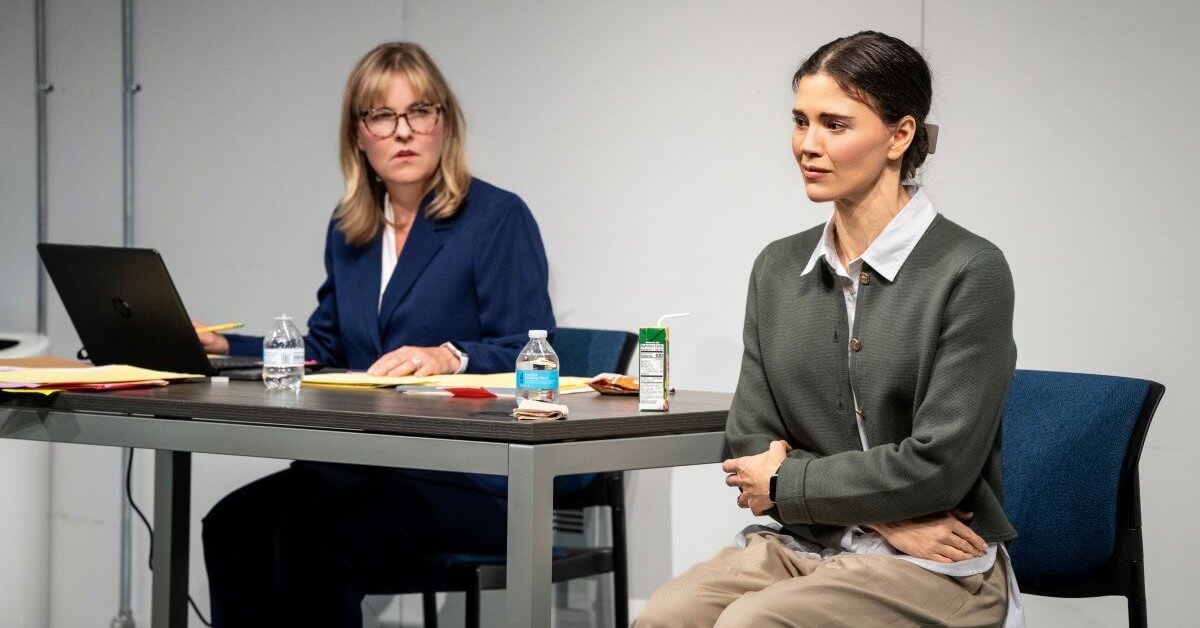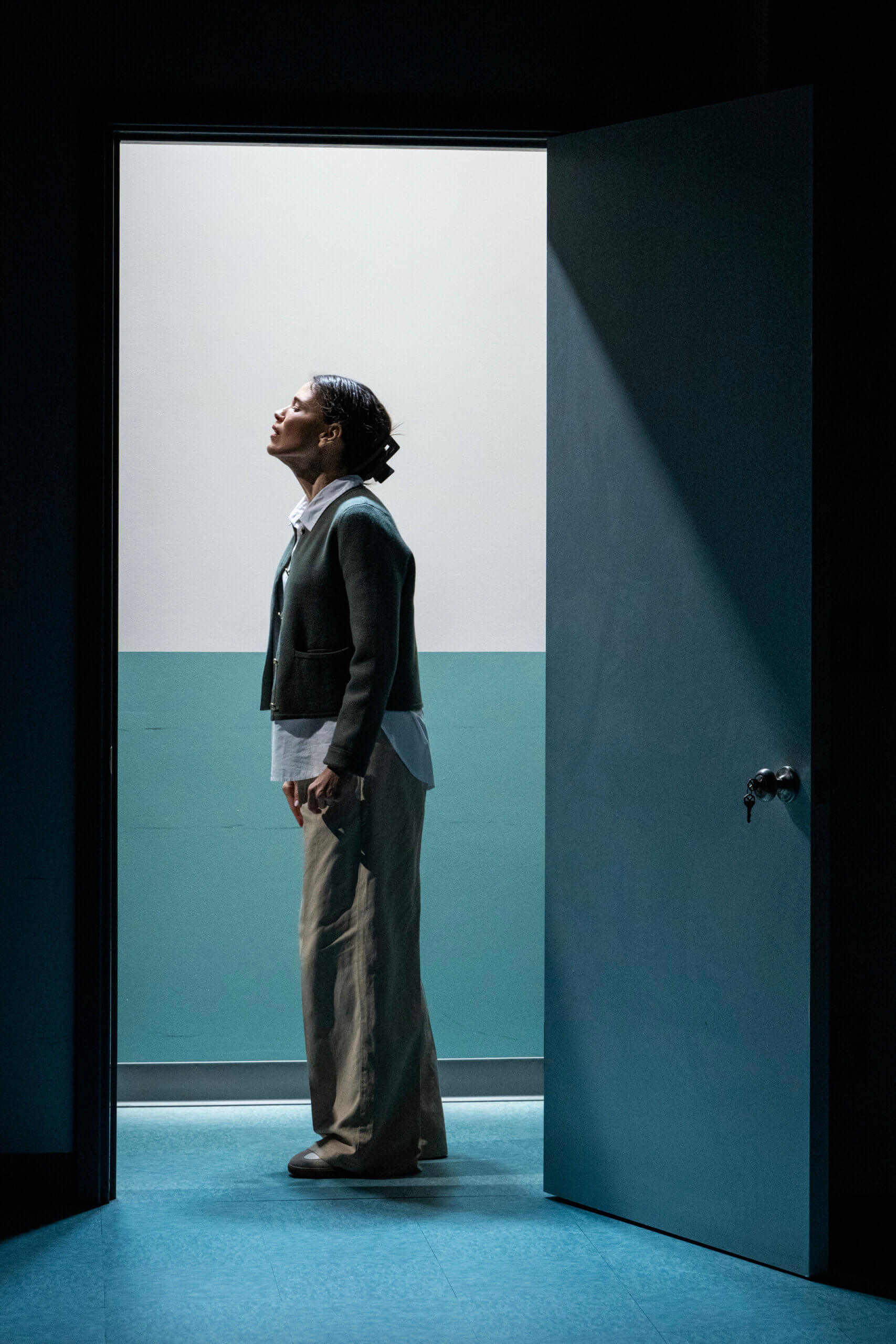
“Blood of the Lamb” Wonders Where We’re Going

When the U. S. Supreme Court knocked down Roe v. Wade in Dobbs v. Jackson Women’s Health Organization, states throughout the country began to enact new laws preventing or severely limiting a number of medical reproductive practices, most especially abortion.
The underlying premise of these measures seems quite simple: Human life begins at the moment of conception. Rather than simply a developing mass of cells, a fetus is a stage in a human being’s development, and as such it has inalienable rights, most especially the right to live.
But if that’s the case, playwright Arlene Hutton wonders in her new play Blood of the Lamb, if a fetus is already a human being with rights of its own, what else might be construed by a state as true or necessary? Prior to the start of the play’s action, Nessa, a pregnant woman flying from Los Angeles to her home in New York City, has gone into distress mid-flight, causing the plane to do an emergency landing in Dallas, Texas, where she then discovers she has lost her baby. As the play opens, she’s brought to a sterile closet-like space in which Jan, a woman whom Nessa takes to be a doctor, questions her about what happened. Quickly Nessa discovers that, in fact, Jan is not a doctor, but a lawyer of the state of Texas representing her dead child. Texas has just passed a law extending the protections against the desecration of a human corpse to fetuses. As such, Nessa learns, she cannot leave the state until the dead child inside her is born naturally, no matter how long that might take or the considerable danger that it poses to her health and life.
It’s an extreme notion to be sure, but in execution “Lamb” has a hard time expanding beyond its initial nightmare thought experiment scenario. Although well played by Kelly McAndrew, Jan embodies just about every stereotype of a Southern conservative you might expect, most especially a religious sensibility that precludes any sense of human decency. “Can I pray with you?” she asks the horrified Nessa at one point, then insists on offering her own quiet prayer anyway. Meanwhile as Nessa, Meredith Garretson is not allowed to be much more than a scared victim of the system. This is Texas by way of The Handmaid’s Tale, and although much of that comparison may be apt, as a story it feels a bit too easy.
Nevertheless, the questions that this play raises are hard to shake. Post-Dobbs, we live in a country where the law on something as fundamental as pregnancy varies to such a degree that crossing a state border is like entering a whole other country. That lack of consistency—and also clarity, as rushed, poorly-conceived laws end up requiring further amendment—dramatically undermines the fabric of our nation.
Blood of the Lamb also highlights the ever-deepening bureaucratization of life in our country. In some ways, the inhumanity of Nessa’s situation is most disturbingly represented in the inchoate and endless paperwork.
Blood of the Lamb also highlights the ever-deepening bureaucratization of life in our country. In some ways, the inhumanity of Nessa’s situation is most disturbingly represented in the inchoate and endless paperwork. “We just need to get through this,” Jan keeps saying as she questions Nessa for online forms Nessa herself is not allowed to see. But like something out of Kafka (or Godot), they’re never able to get through them. And none of the unseen male lawyers and politicians with whom Jan tries to confer seem to care.

In a clever bit of choreography, director Margot Bordelon represents the women’s deepening shared imprisonment by way of Jan’s need to keep moving her table closer to a wall outlet, so she can plug in first her computer, then her phone. With each move, she is further hemmed in by a wall, a table, and the growing obstacle course of her devices’ cords.
And Jan is also further isolated from Nessa, which is in some ways the point: These rules and so many others like them, from the paperwork sometimes required to get a divorce to most businesses’ customer service departments, serve to alienate us from one another and from our own internal instincts toward human decency. In some ways, the most chilling aspect of Blood of the Lamb is the fact that a Christian woman who takes her faith seriously can feel justified in treating another human being in such a frightening and monstrous way. Human history is filled with testimony to the fact that civil and religious laws which inspire or demand that we see one another primarily as objects to be defined and controlled are dangerous. They undermine our humanity. And horrors follow.
Some may walk away from Blood of the Lamb disappointed that it didn’t dig deeper into its characters and its premise. (The fact that the creative team decided to end what was an intense and upsetting seventy minutes with Beyoncé’s upbeat party song “Texas Hold ‘Em” only reinforced some of my own questions about the project.) But the virtue of a work of art lies not in what it fails to accomplish, but what it does. For all of its flaws, Blood of the Lamb asks essential questions about the society that we’re building.

